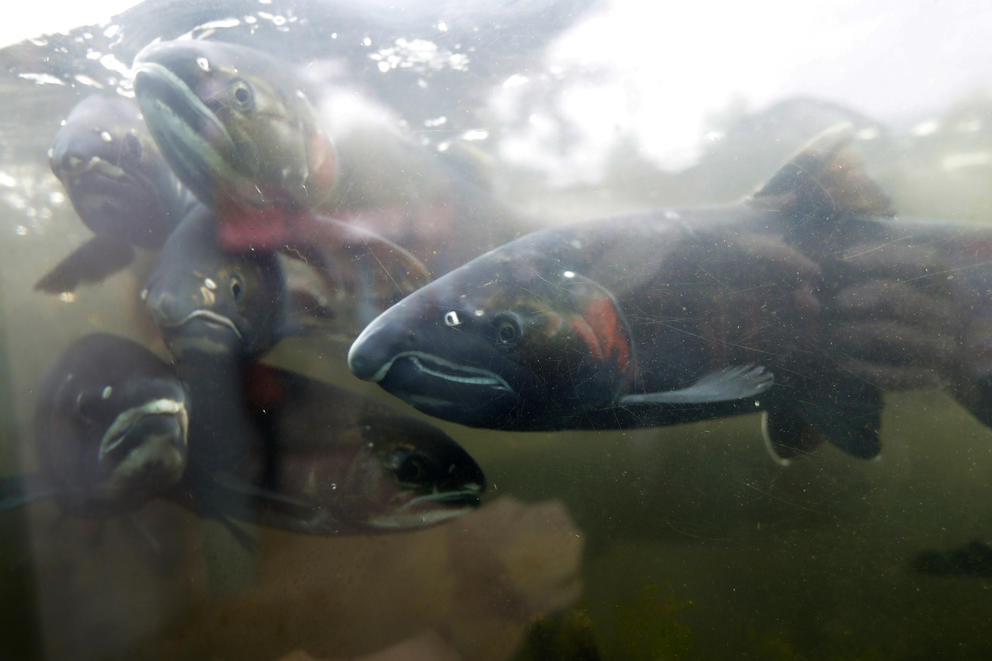The Bonneville Power Administration, the federal agency required to pay for salmon recovery using proceeds from selling power generated by hydroelectric dams, is putting an additional $50 million toward repairs at hatcheries operated by nations and states. The agency also plans to increase annual funding for hatchery upkeep from $500,000 to $2.7 million.
In May, Oregon Public Broadcasting and ProPublica reported on how the federal government’s neglect of an old and struggling hatchery system had put tribal fishing rights in jeopardy. The news organizations’ analysis showed that the outlook for fish survival was so poor that the hatchery system was at risk of collapsing under the strain of climate change, unable to produce meaningful levels of fish. Bonneville is the primary funder of the river’s hatcheries, with additional money coming from federal appropriations and local government. In August, OPB and ProPublica reported that Bonneville had resisted tribal restoration efforts and constrained salmon recovery funds even while generating hundreds of millions of dollars in surplus revenue.
Many salmon habitats were destroyed or drastically altered by the repeated damming of the Columbia in the mid-20th century to create hydropower, provide irrigation and improve shipping navigation. Throughout that period, Congress authorized the dams and turned to hatcheries to compensate for the fish losses.
But hatcheries never ensured that they produced the numbers of fish that nations were promised. Around the time salmon reached endangered status in the late 1980s and 1990s, Indigenous peoples opened their own hatcheries and began reforming them from mass fish-production facilities into nurseries for wild fish that could better preserve genetic diversity and bolster existing natural populations.
Now climate change and warming ocean waters are making matters worse. In recent years, salmon from Columbia River hatcheries have had some of their lowest survival rates on record. Federal scientists estimate salmon survival could further decline by as much as 90% over the next 40 years.
Throughout this unfolding crisis, lawmakers and government agencies have left poorly maintained infrastructure in place, including burst pipes, broken water pumps and crumbling concrete in the walls of aquatic pens that can harbor bacteria and sicken fish.
The $50 million and fivefold increase in hatcheries’ annual budget will begin to address problems stemming in large part from years of limited funding. It will barely make a dent, however, in the infrastructure needs at more than 50 Columbia Basin hatchery programs. According to estimates assembled by state and tribal hatchery managers in 2020, all the needed upgrades and repairs across the Columbia River Basin would total more than $1 billion. Becky Johnson, director of hatchery production for the Nez Perce Tribe in Idaho, said the cost has only grown since then.
Indigenous nations in the Northwest have struggled for years to get the federal government to recognize the inadequacy of its funding for salmon restoration, which is done primarily through the Bonneville Power Administration, an agency torn between mandates to fund conservation work and to operate as a business.
The Affiliated Tribes of Northwest Indians, a coalition of 57 tribes across Oregon, Washington, Idaho and Montana, passed a resolution in January urging the federal government to more effectively and efficiently fund salmon recovery. It passed a similar resolution in 2021.
Yet funding for salmon has not kept pace with inflation, particularly after Bonneville adopted a strategy in 2018 to shore up its budget and reduce debt in part by limiting its fish and wildlife spending.
Indigenous nations and state agencies are asking the Biden administration to use funds from the Inflation Reduction Act and the Bipartisan Infrastructure Deal to upgrade aging hatcheries beyond what the Bonneville increases will cover.
Nations also have gained the attention of Sen. Patty Murray, a Washington Democrat who chairs the Senate Appropriations Committee. A spokesperson for Murray confirmed she was working with nations to identify needs and pursue additional funding.
“Salmon are foundational to Washington state and tribes’ economy, culture, and traditions. Preserving and protecting fish populations will continue to be a top priority I fight for in the other Washington,” Murray said in a statement. “I’ll be considering every option to advance salmon recovery in Washington state and across the greater Pacific Northwest.”
Nations and conservation groups were encouraged by commitments from the Biden administration last year to prioritize Native American rights and to find a long-term solution for the ongoing decline of Columbia River salmon.
“We heard a request to fully fund fish and wildlife restoration and to vest in Tribes and states a stronger role in managing those funds,” the White House said at the time. It went on: “We cannot continue business as usual. Doing the right thing for salmon, Tribal Nations, and communities can bring us together. It is time for effective, creative solutions.”
A year later, the Biden administration remains in negotiations with state officials, tribal governments and environmental groups over the potential for dam removal and how salmon recovery will be funded.
When the Bonneville Power Administration announced a $500 million revenue surplus this year — and its plans to use just 10% of that on fish and wildlife — those parties hoped the Biden administration would intervene. The office of then-Oregon Gov. Kate Brown implored the agency to use more of its surplus on salmon, calling 10% “simply unacceptable.”
Conservation groups and nations agree. “BPA has sort of turned a blind eye,” Mitch Cutter of the Idaho Conservation League said. “We really looked to the administration to make the right decision happen at BPA, and we’re pretty disappointed that that didn’t happen.”
The White House Council on Environmental Quality said it is making sure portions of recent infrastructure bills go to Columbia River nations, including up to $160 million in grants issued through the Pacific Coastal Salmon Recovery Fund. .
White House staff met to discuss Columbia River salmon last week with members of the Nez Perce Tribe, Washington’s Spokane Tribe, an adviser to Oregon Gov. Tina Kotek, and representatives from American Rivers and the National Wildlife Federation.
“The Biden-Harris Administration is making significant investments to support hatcheries and other Tribally-led salmon initiatives,” White House Council on Environmental Quality spokesperson Alyssa Roberts said in an email. “We recognize more must be done and, as President Biden noted last week, we are committed to working together to bring healthy and abundant salmon runs back to the Columbia River System.”
In response to a request for comment, Bonneville spokesperson Kevin Wingert pointed to a document the agency assembled in January addressing tribal concerns and those of conservation groups. The document asserted that Bonneville was meeting its legal obligations to fish and wildlife. It also said Bonneville’s obligations to salmon aren’t tied to how well the agency is doing financially.
“Just as a lack of revenue would not decrease those obligations, an influx of revenue does not increase those obligations,” the document stated.
But even if it were to address a maintenance backlog estimated at $1 billion, the Columbia hatchery system would still be lacking the upgrades scientists say are necessary to make the facilities and the fish they breed more resilient to the effects of climate change. Those include circular tanks instead of concrete pens, more precise control of water temperature and additional ponds and feeding techniques that better simulate the natural environment.
Those changes would require additional billions of dollars.
“It’s basically a drop in the bucket,” Johnson said of the funding increase. “But a start, right?”



